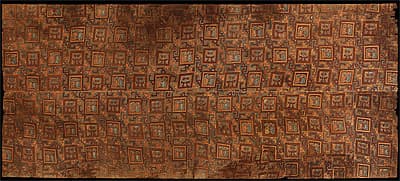
CHANCAY culture Central coast 1200 – 1450 AD
Painted textile c. 1400 AD cotton and pigments , painted147.0 (h) x 328.0 (w) cm Fundación Museo Amano, Lima Photograph: Daniel Giannoni
The Chancay added painting to their repertoire of decorative textile techniques, applying pigments to the surface of plain-weave cotton cloth. The colours were usually limited to shades of brown and yellow, although textiles patterned with more brilliant hues such as orange, brighter yellows and, in this case green, have also been found. Sometimes resist processes were used when applying the colour to sections of the blank cloth. Resist methods include tying-off sections of cloth and painting on substances like wax, to be later removed, to repel the application of another colour.1 The benefit of painting on designs rather than creating patterns during the weaving process was speed: the painting could be done a lot more quickly. The Chancay did encounter problems with their painting textile decoration, however, especially in achieving designs with straight lines and geometric grids that appear more crisply on some woven cloth.
Here two lengths of plain cloth were painted separately before being stitched together. However, the overall repeated pattern of decorative squares does not match precisely along the central seam of the resulting large textile. A brown standing human figure, arms and legs outstretched and wearing a blue-green headdress, appears in alternate boxes. His face is divided in two, with a brown upper and blue-green lower half, suggesting he perhaps wears a mask. The squares are outlined three times with two different brown pigments, one a reddish shade.
The intervening boxes display two orange and blue birds seated back to back. Here the surrounding outlines are in orange and brown. Since all the figures are outlined in white, they appear prominently in a design dominated by orange and brown. The cohesive geometric pattern across the entire textile is achieved by painting a crooked step pattern between the squares.
Simeran Maxwell
1. Rebecca Stone-Miller, To weave for the sun: Andean textiles in the Museum of Fine Arts, Boston, Boston: Museum of Fine Arts 1992, p. 46.
The Chancay added painting to their repertoire of decorative textile techniques, applying pigments to the surface of plain-weave cotton cloth. The colours were usually limited to shades of brown and yellow, although textiles patterned with more brilliant hues such as orange, brighter yellows and, in this case green, have also been found. Sometimes resist processes were used when applying the colour to sections of the blank cloth. Resist methods include tying-off sections of cloth and painting on substances like wax, to be later removed, to repel the application of another colour.1 The benefit of painting on designs rather than creating patterns during the weaving process was speed: the painting could be done a lot more quickly. The Chancay did encounter problems with their painting textile decoration, however, especially in achieving designs with straight lines and geometric grids that appear more crisply on some woven cloth.
Here two lengths of plain cloth were painted separately before being stitched together. However, the overall repeated pattern of decorative squares does not match precisely along the central seam of the resulting large textile. A brown standing human figure, arms and legs outstretched and wearing a blue-green headdress, appears in alternate boxes. His face is divided in two, with a brown upper and blue-green lower half, suggesting he perhaps wears a mask. The squares are outlined three times with two different brown pigments, one a reddish shade.
The intervening boxes display two orange and blue birds seated back to back. Here the surrounding outlines are in orange and brown. Since all the figures are outlined in white, they appear prominently in a design dominated by orange and brown. The cohesive geometric pattern across the entire textile is achieved by painting a crooked step pattern between the squares.
Simeran Maxwell
1. Rebecca Stone-Miller, To weave for the sun: Andean textiles in the Museum of Fine Arts, Boston, Boston: Museum of Fine Arts 1992, p. 46.
The Chancay added painting to their repertoire of decorative textile techniques, applying pigments to the surface of plain-weave cotton cloth. The colours were usually limited to shades of brown and yellow, although textiles patterned with more brilliant hues such as orange, brighter yellows and, in this case green, have also been found. Sometimes resist processes were used when applying the colour to sections of the blank cloth. Resist methods include tying-off sections of cloth and painting on substances like wax, to be later removed, to repel the application of another colour.1 The benefit of painting on designs rather than creating patterns during the weaving process was speed: the painting could be done a lot more quickly. The Chancay did encounter problems with their painting textile decoration, however, especially in achieving designs with straight lines and geometric grids that appear more crisply on some woven cloth.
Here two lengths of plain cloth were painted separately before being stitched together. However, the overall repeated pattern of decorative squares does not match precisely along the central seam of the resulting large textile. A brown standing human figure, arms and legs outstretched and wearing a blue-green headdress, appears in alternate boxes. His face is divided in two, with a brown upper and blue-green lower half, suggesting he perhaps wears a mask. The squares are outlined three times with two different brown pigments, one a reddish shade.
The intervening boxes display two orange and blue birds seated back to back. Here the surrounding outlines are in orange and brown. Since all the figures are outlined in white, they appear prominently in a design dominated by orange and brown. The cohesive geometric pattern across the entire textile is achieved by painting a crooked step pattern between the squares.
Simeran Maxwell
1. Rebecca Stone-Miller, To weave for the sun: Andean textiles in the Museum of Fine Arts, Boston, Boston: Museum of Fine Arts 1992, p. 46.

